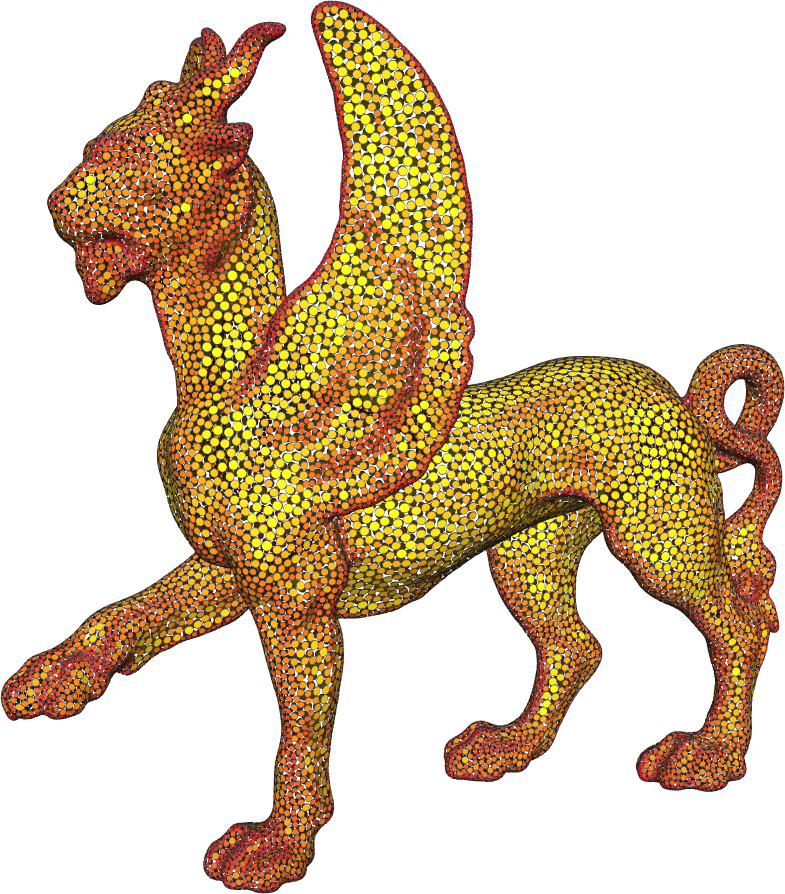SCI Publications
2008


M.D. Meyer, R.T. Whitaker, R.M. Kirby, C. Ledergerber, H. Pfister.
“Particle-based Sampling and Meshing of Surfaces in Multimaterial Volumes,” In IEEE Transactions on Visualization and Computer Graphics, Vol. 14, No. 6, pp. 1539--1546. 2008.


M.D. Meyer.
“Dynamic Particle Systems for Adaptive Sampling of Implicit Surfaces,” School of Computing, University of Utah, 2008.
A ubiquitous requirement in many mathematical and computational problems is a set of well-placed point samples. For producing very even distributions of samples across complex surfaces, a dynamic particle system is a controllable mechanism that naturally accommodates strict sampling requirements. The systemfirst constrains particles to a surface, and then moves the particles across the surface until they are arranged in minimal energy configurations. Adaptivity is added into the system by scaling the distance between particles, causing higher densities of points around surface features. In this dissertation we explore and refine the dynamics of particle systems for generating efficient and adaptive point samples of implicit surfaces.
Throughout this dissertation, we apply the adaptive particle system framework to several application areas. First, efficient visualizations of high-order finite element datasets are generated by developing adaptivity metrics of surfaces that exist in the presence of curvilinear coordinate transformation. Second, a framework is proposed that meets fundamental sampling constraints of Delaunay-based surface reconstruction algorithms. In meeting these constraints, the particle distributions produce nearly-regular, efficient isosurface tessellation that are geometrically and topologically accurate. And third, a novel analytic representation of material boundaries in multimaterial volume datasets is developed, as well as a set of projection operators, that allow for explicit sampling of nonmanifold material intersections. Using a tetrahedral labeling algorithm, the material intersections are extracted as watertight, nonmanifold meshes that are well-suited for simulations.

L. Moreau, B. Ludäscher, I. Altintas, R. Barga, S. Bowers, S.P. Callahan, G. Chin Jr., B. Clifford, S. Cohen, S. Cohen-Boulakia, S. Davidson, E. Deelman, L. Digiampietri, I. Foster, J. Freire, J. Frew, J. Futrelle, T. Gibson, Y. Gil, C. Goble, J. Golbeck, P. Groth, D. A. Holland, S. Jiang, J. Kim, D. Koop, A. Krenek, T. McPhillips, G. Mehta, S. Miles, D. Metzger, S. Munroe, J. Myers, B. Plale, N. Podhorszki, V. Ratnakar, E. Santos, C.E. Scheidegger, K. Schuchardt, M. Seltzer, Y. L. Simmhan, C.T. Silva, P. Slaughter, E. Stephan, R. Stevens, D. Turi, H.T. Vo, M. Wilde, J. Zhao, Y. Zhao.
“The First Provenance Challenge,” In Concurrency and Computation: Practice and Experience, Vol. 20, No. 5, pp. 409--418. April, 2008.


L. Moreau, J. Freire, J. Futrelle, R.E. McGrath, J. Myers, P. Paulson.
“The Open Provenance Model: An Overview,” In Provenance and Annotation of Data and Processes, Lecture Notes in Computer Science (LNCS), pp. 323--326. 2008.
ISBN: 978-3-540-89964-8


N. Mukherjee, C. Kang, H.M. Wolfe, B.S. Hertzberg, J.K. Smith, W. Lin, G. Gerig, R.M. Hamer, J.H. Gilmore.
“Discordance of Prenatal and Neonatal Brain Development in Twins,” In Early Human Development, pp. (in press). August, 2008.


E.P. Newren, A.L. Fogelson, R.D. Guy, R.M. Kirby.
“A Comparison of Implicit Solvers for the Immersed Boundary Equations,” In Computer Methods in Applied Mechanics and Engineering, Vol. 197, No. 25--28, pp. 2290--2304. 2008.
DOI: 10.1016/j.cma.2007.11.030


H. Nguyen, T. Nguyen, J. Freire.
“Learning to Extract Form Labels,” In Proceedings of the VLDB Endowment, Vol. 1, No. 1, VLDB Endowment, pp. 684--694. Aug, 2008.
DOI: 10.14778/1453856.1453931


H. Nguyen, E.Y. Kang, J. Freire.
“Automatically Extracting Form Labels,” In Proceedings of the 2008 IEEE 24th International Conference on Data Engineering, pp. 1498--1500. 2008.


T. Ochotta, D. Saupe.
“Image-Based Surface Compression,” In Computer Graphics Forum, Vol. 27, No. 6, pp. 1647--1663. 2008.


I. Oguz, J. Cates, P.T. Fletcher, R.T. Whitaker, D. Cool, S. Aylward, M. Styner.
“Cortical Correspondence using Entropy-Based Particle Systems and Local Features,” In 5th IEEE International Symposium on Biomedical Imaging: From Nano to Macro, 2008. (ISBI 2008), pp. 1637--1640. 2008.

R. Palmer, M. DeLisi, G. Gopalakrishnan, R.M. Kirby.
“An Approach to Formalization and Analysis of Message Passing Libraries,” In Proceedings of the 12th International Workshop on Formal Methods for Industrial Critical Systems (FMICS 2007), Berlin, Germany, Vol. 4916/2008, Note: Awarded Best Paper., pp. 164--181. 2008.


V. Pegoraro, I. Wald, S.G. Parker.
“Sequential Monte Carlo Adaptation in Low-Anisotropy Participating Media,” In Proceedings of the 19th Eurographics Symposium on Rendering, pp. 1097--1104. 2008.


V. Pegoraro, C. Brownlee, P.S. Shirley, S.G. Parker.
“Towards Interactive Global Illumination Effects via Sequential Monte Carlo Adaptation,” In Proceedings of the 3rd IEEE Symposium on Interactive Ray Tracing, pp. 107--114. 2008.

N.S. Phatak, S.A. Maas, A.I. Veress, N.A. Pack, E.V.R. Di Bella, J.A. Weiss.
“Strain measurement in the left ventricle during systole with deformable image registration,” In Medical Image Analysis, pp. (in press). 2008.


S. Pizer, M. Styner, T. Terriberry, R. Broadhurst, S. Joshi, E. Chaney, P.T. Fletcher.
“Statistical Applications with Deformable M-Reps,” In Computational Imaging and Vision, Springer, pp. 269--308. 2008.
DOI: 10.1007/978-1-4020-8658-8_9


K. Potter, J. Krüger, C.R. Johnson.
“Towards the Visualization of Multi-Dimentional Stochastic Distribution Data,” In Proceedings of The International Conference on Computer Graphics and Visualization (IADIS) 2008, pp. 191--196. 2008.


M.W. Prastawa, G. Gerig.
“Brain Lesion Segmentation Through Physical Model Estimation,” In Lecture Notes in Computer Science, Vol. 5358, pp. 562--571. 2008.
DOI: 10.1007/978-3-540-89639-5_54

T. Preusser, H. Scharr, K. Krajsek, R.M. Kirby.
“Building Blocks for Computer Vision with Stochastic Partial Differential Equations,” In International Journal of Computer Vision, Vol. 80, No. 3, Springer, pp. 375--405. July, 2008.
DOI: 10.1007/s11263-008-0145-5


J.C. Principe, J. Xu, R. Jenssen, A.R.C. Paiva, I. Park.
“A Reproducing Kernel Hilbert Space framework for Information-Theoretic Learning,” In IEEE Transactions on Signal Processing, Vol. 56, No. 12, Edited by J.C. Principe, IEEE, pp. 5891--5902. Dec, 2008.
ISBN: 978-1-4419-1569-6
DOI: 10.1109/tsp.2008.2005085


M. Rullmann, A. Anwander, M. Dannhauer, S.K. Warfield, F.H. Duffy, C.H. Wolters.
“EEG Source Analysis of Epileptiform Activity Using a 1mm Anisotropic Hexahedra Finite Element Head Model.,” In NeuroImage, Vol. 44, No. 2, pp. 399--410. 2008.
DOI: 10.1016/j.neuroimage.2008.09.009





